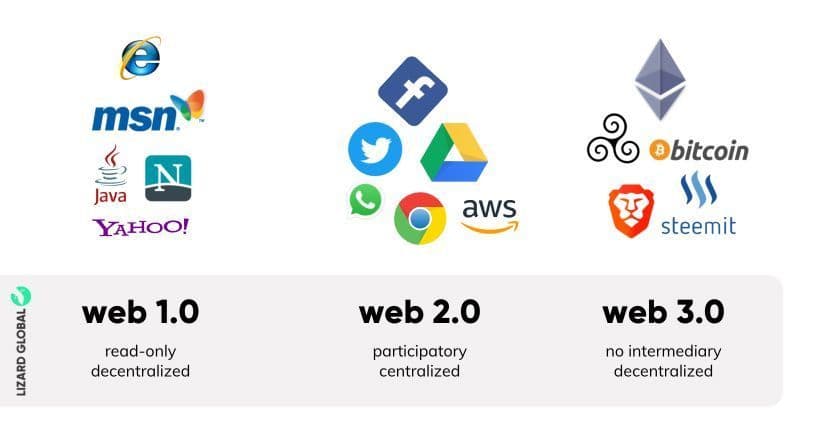web 3
web 3.0
+ 5 more ...
What is Web 3 and How Will it Change the Internet as We Know it?
13 Jun 2023
by Lotte, Digital Content Specialist & Asrul Ash
13 Jun 2023
by Lotte, Digital Content Specialist & Asrul Ash
web 3
web 3.0
internet of things
digitization
digital transformation
app development
progressive web apps
What is Web 3 and How Will it Change the Internet as We Know it?
Table of contents
Contact us
We will get back to you in the next 48 hours.

Web 3.0 is on its way, and it won’t be long before the Internet is turning into a decentralized and independent environment, in which you decide what happens to your data.
Follow Lizard Global on Facebook, Instagram, and LinkedIn.
The so-called third "generation" of the Internet appears to be closer than we think it is, and it promises to decentralize content regulation, enable new AI processes, welcome the metaverse, and accept digital currencies as its primary payment method. Web 3, or Web 3.0 is a term you've probably already come across if you’re an Internet veteran. It refers to the internet's next generation, which encourages decentralized protocols and strives to lessen our reliance on giant digital companies like Youtube, Netflix, and Amazon. But what exactly is it, and how is it changing how we interact with the internet and our applications?
What is Web 3.0?
To fully grasp why and how technological advancements have an impact on the way we experience (web) apps, we need to start with the basics. So, what is Web 3.0? And where does it come from?
Web 3.0 is one of the most recent Internet technologies, combining machine learning, artificial intelligence, and blockchain to enable real-time human communication. Web 3.0 will allow individuals to not only own and control their data but also to get reimbursed for their online time.
Because Web 3.0 has not yet been deployed, there is no firm definition, and it is based on an idea rather than solid facts that can be studied. However, to make sure you’re ahead of the competition, it’s always a good idea to be prepared for what’s about to come.
A bit of history
It's important to know what came before Web 3 to understand what’s going to change. Web 1 was the initial version of the Internet, which consisted of a collection of links and homepages. It was released in the late 1990s. Generally, the websites were not very interactive. So, apart from reading and publishing basic stuff for others to read, you couldn't do much. These were the major technologies that made up Web 1.0:
- HTML (HyperText Markup Language)
- HTTP (Hypertext Transfer Protocol)
- URL (Uniform Resource Locator)
After Web 1 came Web 2. Some people refer to this version of the internet as the "read/write" version, referring to the computer code that allows you to open and change files rather than just viewing them. People could not only consume content on this version of the Internet, but also produce it and post it on blogs like Tumblr, Reddit, Internet forums, and marketplaces like Craigslist. Later, the rise of social media platforms such as Facebook, Twitter, and Instagram raised content creating and sharing to new levels.
Web 2 consisted of three innovation layers:
- Social media platforms
- Cloud Computing
- Mobile use
Even though Web 2 has provided the world with a lot of free and on-demand services, many users have become dissatisfied with these so-called "walled gardens'', created by massive tech businesses. A rapidly increasing number of people want more control over their data and the content they see. This is where Web 3 enters the picture.
Web 3 is also referred to as the "read/write/own" phase of the Internet. Users can engage in the management of internet protocols directly, rather than using free tech platforms in exchange for their data, which is the case with platforms like Facebook and Instagram. This means that users are becoming participants and stockholders, rather than mere information sources.

The importance of ownership
Advanced technologies such as cryptocurrencies and (non-fungible) tokens will play a leading role in Web 3.0 since they reflect a sense of ownership in decentralized blockchain networks. Think of the latest hype of NFTs, or non-fungible tokens, which shifts the ownership of a specific form of money, which is the case with cryptocurrencies, to the ownership of many other digital assets, from artworks to memes and tweets.
Web 3 enables the spread of cooperative governance frameworks for formerly centralized products. A joke, a piece of art, a person's social media output, or tickets to your favorite events are all examples of tokenization. The gaming business is a fantastic example of the paradigm shift. Gamers often complain about the problems and bugs that keep popping up in their favorite video game. Web 3 allows players to invest in the game and vote on how it should be run. It is a collaborative effort between game developers and the players themselves. Web 3 is being used by large Web 2 firms like Meta and Ubisoft to create virtual worlds, like Facebook’s Metaverse. Non-fungible tokens (NFT) will also help to reshape the gaming business by allowing players to become the immutable owners of specific in-game items they acquire.

Key features of Web 3.0
Web 3.0 comes with a few key features that will change the way we currently interact with the Internet and web applications:
Open-source
Web 3.0 is 'open' in the sense that most of its assets are created using open-source software by an open and accessible community of developers, in full view of the public. Transparency is key here, creating a more trustworthy digital environment.
Decentralized
Users have the option to engage openly and privately without the interference of an intermediary party. Their actions are taking place in a decentralized space, giving them more freedom and control to manage their data.
Permissionless
Without the necessity for approval from a controlling and centralized organization, everyone, including users and providers, can participate on an equal level in Web 3.0.
Ubiquitous access
Web 3.0 allows us to access the Internet at any time and from any location. Web-connected gadgets will no longer be confined to computers and cell phones at some time in the future, as they were in Web 2.0. Technology will enable the development of a plethora of new sorts of intelligent gadgets as a result of the Internet of Things (IoT).
How does Web 3.0 work?
One of the goals of Web 3.0 is to make Internet searches significantly faster, easier, and more efficient so that even complicated search words can be processed quickly.
Nowadays, a user must engage with the front end of a web 2.0 application, which communicates with the backend, which then communicates with the database. The complete code is stored on centralized servers and delivered to consumers via a web browser.
Web 3.0 lacks both centralized databases for application state storage and a centralized web server for backend processing. Instead, a blockchain can be used to create apps that run on a decentralized server and are maintained by anonymous nodes on the internet.
Web 3.0 and Decentralized Applications
One big aspect and major promise of Web 3.0 is the emergence of so-called decentralized applications or DApps. A decentralized application is similar to an app found on your smartphone or laptop, but it uses blockchain technology to keep users' data out of the hands of the companies behind it. Dapps are decentralized apps, just like cryptocurrency is decentralized money.
The blockchain simultaneously maintains copies of its growing stack of data on a huge number of collaborating computers, referred to as "nodes." These computers belong to the users, not the DApp's creators. DApps can provide social networks, gaming, entertainment, productivity tools, and more, just like traditional apps. Many are intended to assist customers in gaining access to decentralized financial services, also known as DeFi.
Web app versus dApp
Generally, traditional web applications' usefulness is determined by the front end and the back end. Web apps rely on software that runs on centralized web servers rather than the device's native operating system. When you open Facebook in your web browser, for example, the feed that appears (the front end) is derived from data stored on the company's web server (the backend).
While the internet continuously transmits vast volumes of data through massive, centralized servers, a blockchain is made up of hundreds or even thousands of devices that share the transactional weight over a distributed network. Decentralized apps and web apps generally employ the same technology to render a page on the internet on the front end. On the backend, however, dApps communicate with their blockchain networks via a wallet that acts as a gateway to the blockchain ecosystem.
Wallets keep track of your blockchain address as well as the cryptographic keys you'll need to identify and verify yourself. DApp wallets activate smart contracts that interact with the blockchain and conduct transactions, instead of using the HTTP protocol. While the user experience (UX) of a well-designed decentralized application may appear similar to that of a web app, it differs in that it lacks servers, HTTP interactions, and potential censorship. The

Benefits of Web 3.0
Web 3.0 has quite some advantages over Web 2.0 and the way we currently use the Internet. It will make the web smarter, safer, and more transparent, allowing for more efficient surfing and human-machine interaction.
Data privacy
End-users will benefit the most from advanced data encryptions to make it impossible for major corporations like Google and Apple to manage or use people's personal information for their gain without your say. This way, consumers will have complete control over and privacy over their data.
Consistent Services
Users will be able to access data in any situation thanks to decentralized data storage. They will receive several backups, which allows them to access their data even if the server fails. Furthermore, no entity or government agency will be able to halt the operation of any services or websites. As a result, the chances of account suspension and distributed service denial will be lowered.
Objectivity
End-users will follow their data and inspect the code behind the platform regardless of which blockchain platform they choose. The majority of blockchain systems are developed by non-profit organizations, which means that they provide an open-source blockchain platform that allows for open design and development procedures without the focus on generating profits.
Data accessibility
Data will be available from any location and on any device. By allowing smartphones and other connected devices to access data, the goal is to expand data collection and accessibility to people all over the world, no matter the location. Web 3.0 broadens the scope of engagement by allowing for frictionless payments, richer information flows, and secure data transfers.
No restrictions
Users can build their programs or engage with the blockchain network because it is open to anyone. The 3.0 network does not discriminate against users based on their gender, income, geographic region, socio-economic status, or background.
One profile for all services
Users no longer need to create separate personal profiles for multiple platforms. A single profile can be interconnected with and used on any platform, and the user retains complete control over any personal data. No corporation can access or verify the accuracy of users' data without their explicit authorization. Users have the freedom of choosing to share their profiles and sell their data to advertising and brands.
Need a hand?
As you can see, Web 3.0 has a lot of potential, and it won’t be long before our interactions with the Internet will shift towards an enhanced and independent experience. Want to know more about Web 3.0 or do you want to have your very own application developed by experts in the field, using the latest technologies and following the latest trends? Fill out the contact form on our website to receive a free digital consultation session.


Web 3.0 is on its way, and it won’t be long before the Internet is turning into a decentralized and independent environment, in which you decide what happens to your data.
Follow Lizard Global on Facebook, Instagram, and LinkedIn.
The so-called third "generation" of the Internet appears to be closer than we think it is, and it promises to decentralize content regulation, enable new AI processes, welcome the metaverse, and accept digital currencies as its primary payment method. Web 3, or Web 3.0 is a term you've probably already come across if you’re an Internet veteran. It refers to the internet's next generation, which encourages decentralized protocols and strives to lessen our reliance on giant digital companies like Youtube, Netflix, and Amazon. But what exactly is it, and how is it changing how we interact with the internet and our applications?
What is Web 3.0?
To fully grasp why and how technological advancements have an impact on the way we experience (web) apps, we need to start with the basics. So, what is Web 3.0? And where does it come from?
Web 3.0 is one of the most recent Internet technologies, combining machine learning, artificial intelligence, and blockchain to enable real-time human communication. Web 3.0 will allow individuals to not only own and control their data but also to get reimbursed for their online time.
Because Web 3.0 has not yet been deployed, there is no firm definition, and it is based on an idea rather than solid facts that can be studied. However, to make sure you’re ahead of the competition, it’s always a good idea to be prepared for what’s about to come.
A bit of history
It's important to know what came before Web 3 to understand what’s going to change. Web 1 was the initial version of the Internet, which consisted of a collection of links and homepages. It was released in the late 1990s. Generally, the websites were not very interactive. So, apart from reading and publishing basic stuff for others to read, you couldn't do much. These were the major technologies that made up Web 1.0:
- HTML (HyperText Markup Language)
- HTTP (Hypertext Transfer Protocol)
- URL (Uniform Resource Locator)
After Web 1 came Web 2. Some people refer to this version of the internet as the "read/write" version, referring to the computer code that allows you to open and change files rather than just viewing them. People could not only consume content on this version of the Internet, but also produce it and post it on blogs like Tumblr, Reddit, Internet forums, and marketplaces like Craigslist. Later, the rise of social media platforms such as Facebook, Twitter, and Instagram raised content creating and sharing to new levels.
Web 2 consisted of three innovation layers:
- Social media platforms
- Cloud Computing
- Mobile use
Even though Web 2 has provided the world with a lot of free and on-demand services, many users have become dissatisfied with these so-called "walled gardens'', created by massive tech businesses. A rapidly increasing number of people want more control over their data and the content they see. This is where Web 3 enters the picture.
Web 3 is also referred to as the "read/write/own" phase of the Internet. Users can engage in the management of internet protocols directly, rather than using free tech platforms in exchange for their data, which is the case with platforms like Facebook and Instagram. This means that users are becoming participants and stockholders, rather than mere information sources.

The importance of ownership
Advanced technologies such as cryptocurrencies and (non-fungible) tokens will play a leading role in Web 3.0 since they reflect a sense of ownership in decentralized blockchain networks. Think of the latest hype of NFTs, or non-fungible tokens, which shifts the ownership of a specific form of money, which is the case with cryptocurrencies, to the ownership of many other digital assets, from artworks to memes and tweets.
Web 3 enables the spread of cooperative governance frameworks for formerly centralized products. A joke, a piece of art, a person's social media output, or tickets to your favorite events are all examples of tokenization. The gaming business is a fantastic example of the paradigm shift. Gamers often complain about the problems and bugs that keep popping up in their favorite video game. Web 3 allows players to invest in the game and vote on how it should be run. It is a collaborative effort between game developers and the players themselves. Web 3 is being used by large Web 2 firms like Meta and Ubisoft to create virtual worlds, like Facebook’s Metaverse. Non-fungible tokens (NFT) will also help to reshape the gaming business by allowing players to become the immutable owners of specific in-game items they acquire.

Key features of Web 3.0
Web 3.0 comes with a few key features that will change the way we currently interact with the Internet and web applications:
Open-source
Web 3.0 is 'open' in the sense that most of its assets are created using open-source software by an open and accessible community of developers, in full view of the public. Transparency is key here, creating a more trustworthy digital environment.
Decentralized
Users have the option to engage openly and privately without the interference of an intermediary party. Their actions are taking place in a decentralized space, giving them more freedom and control to manage their data.
Permissionless
Without the necessity for approval from a controlling and centralized organization, everyone, including users and providers, can participate on an equal level in Web 3.0.
Ubiquitous access
Web 3.0 allows us to access the Internet at any time and from any location. Web-connected gadgets will no longer be confined to computers and cell phones at some time in the future, as they were in Web 2.0. Technology will enable the development of a plethora of new sorts of intelligent gadgets as a result of the Internet of Things (IoT).
How does Web 3.0 work?
One of the goals of Web 3.0 is to make Internet searches significantly faster, easier, and more efficient so that even complicated search words can be processed quickly.
Nowadays, a user must engage with the front end of a web 2.0 application, which communicates with the backend, which then communicates with the database. The complete code is stored on centralized servers and delivered to consumers via a web browser.
Web 3.0 lacks both centralized databases for application state storage and a centralized web server for backend processing. Instead, a blockchain can be used to create apps that run on a decentralized server and are maintained by anonymous nodes on the internet.
Web 3.0 and Decentralized Applications
One big aspect and major promise of Web 3.0 is the emergence of so-called decentralized applications or DApps. A decentralized application is similar to an app found on your smartphone or laptop, but it uses blockchain technology to keep users' data out of the hands of the companies behind it. Dapps are decentralized apps, just like cryptocurrency is decentralized money.
The blockchain simultaneously maintains copies of its growing stack of data on a huge number of collaborating computers, referred to as "nodes." These computers belong to the users, not the DApp's creators. DApps can provide social networks, gaming, entertainment, productivity tools, and more, just like traditional apps. Many are intended to assist customers in gaining access to decentralized financial services, also known as DeFi.
Web app versus dApp
Generally, traditional web applications' usefulness is determined by the front end and the back end. Web apps rely on software that runs on centralized web servers rather than the device's native operating system. When you open Facebook in your web browser, for example, the feed that appears (the front end) is derived from data stored on the company's web server (the backend).
While the internet continuously transmits vast volumes of data through massive, centralized servers, a blockchain is made up of hundreds or even thousands of devices that share the transactional weight over a distributed network. Decentralized apps and web apps generally employ the same technology to render a page on the internet on the front end. On the backend, however, dApps communicate with their blockchain networks via a wallet that acts as a gateway to the blockchain ecosystem.
Wallets keep track of your blockchain address as well as the cryptographic keys you'll need to identify and verify yourself. DApp wallets activate smart contracts that interact with the blockchain and conduct transactions, instead of using the HTTP protocol. While the user experience (UX) of a well-designed decentralized application may appear similar to that of a web app, it differs in that it lacks servers, HTTP interactions, and potential censorship. The

Benefits of Web 3.0
Web 3.0 has quite some advantages over Web 2.0 and the way we currently use the Internet. It will make the web smarter, safer, and more transparent, allowing for more efficient surfing and human-machine interaction.
Data privacy
End-users will benefit the most from advanced data encryptions to make it impossible for major corporations like Google and Apple to manage or use people's personal information for their gain without your say. This way, consumers will have complete control over and privacy over their data.
Consistent Services
Users will be able to access data in any situation thanks to decentralized data storage. They will receive several backups, which allows them to access their data even if the server fails. Furthermore, no entity or government agency will be able to halt the operation of any services or websites. As a result, the chances of account suspension and distributed service denial will be lowered.
Objectivity
End-users will follow their data and inspect the code behind the platform regardless of which blockchain platform they choose. The majority of blockchain systems are developed by non-profit organizations, which means that they provide an open-source blockchain platform that allows for open design and development procedures without the focus on generating profits.
Data accessibility
Data will be available from any location and on any device. By allowing smartphones and other connected devices to access data, the goal is to expand data collection and accessibility to people all over the world, no matter the location. Web 3.0 broadens the scope of engagement by allowing for frictionless payments, richer information flows, and secure data transfers.
No restrictions
Users can build their programs or engage with the blockchain network because it is open to anyone. The 3.0 network does not discriminate against users based on their gender, income, geographic region, socio-economic status, or background.
One profile for all services
Users no longer need to create separate personal profiles for multiple platforms. A single profile can be interconnected with and used on any platform, and the user retains complete control over any personal data. No corporation can access or verify the accuracy of users' data without their explicit authorization. Users have the freedom of choosing to share their profiles and sell their data to advertising and brands.
Need a hand?
As you can see, Web 3.0 has a lot of potential, and it won’t be long before our interactions with the Internet will shift towards an enhanced and independent experience. Want to know more about Web 3.0 or do you want to have your very own application developed by experts in the field, using the latest technologies and following the latest trends? Fill out the contact form on our website to receive a free digital consultation session.

FAQs

What is web 3.0?







